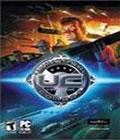Genre: Simulation
Publisher: 3000AD Inc
Developer: 3000AD Inc
Release Date: August 3, 2005
Most released games appeal to a wide swath of players – first-person shooters, real-time strategy, and varied simulations. Some games are geared towards a more niche market, like the one at the center of this review, Universal Combat: A World Apart.
Ever since X-Wing, space-based flight combat titles have been my favorite games, but in recent years, there has been a dearth of them, so imagine my excitement when selecting UC: AWA, which, from all indicators appeared to be a space-based flight combat title.
Upon installation, however, I began to realize that I had made an incorrect assumption. Instead of a combat simulation, however, as the "Combat" portion of Universal Combat might indicate, AWA is a command simulation title. In all my years of gaming, I have only encountered this once before, in Harpoon, which was billed as a tool the Navy used to train commanders and appeared to be an RTS at first glance, but was actually a very complex battle simulation on the open ocean.
AWA places you on the bridge of a capital ship as a ship captain. For the player, this entails a much more complex game than the conventional space combat scenario, and you must command troop allocation within your ship – assigning pilots, flight engineers, medics and marines to various duties within the vessel, fighters or shuttlecraft. There is also a first-person shooter aspect to the game, but more on that in a bit.
As I do in every game, I initially try to play without reading the manual, just launching right in to it to see how good the tutorial is and how intuitive the controls and menus are. For a majority of games, I find that I can play them without reading the documentation, and in the worst cases, I've managed after viewing a one-page listing of keyboard commands.
This is most definitely not the case in UC: AWA. The screen fills with a multitude of buttons and sub-screens, almost all of which have non-intuitive initials instead of full descriptions. The size of space is "realistic," which means that to the player's point of view, moving along at normal flight speed means weeks of travel between points (the manual implies that the game does allow this type of travel, but I don't have the patience to test that). Since you are piloting a capital ship, it is not exactly a responsive craft, so turning and maneuvering is very slow. After struggling to play with only a short list of keyboard commands, I conceded that it was beyond me, so I opened up the manual.
Shock and horror! The manual is over 100 pages long. It's all right, I say to myself. There is another document entitled "ucawa_tutorial.pdf," which is sure to be the tutorial presented in text instead of in-game. So I open it up … and found it to be slightly shorter, at 97 pages.
Conceding to the reality of this, I open up the game and go through the steps detailed in the tutorial to begin the scenario. It walks you through, using Hyperspace to move to a location to engage a non-responsive vessel both with guns and missiles, then changing to another target to launch fighters at another target. Even with step-by-step instructions open beside me, the game remains difficult to play, with all actions requiring navigation through a cacophony of displays.
After working through a portion of the command scenario (with frustration building at the complexity), I came to the conclusion that it was more than I was able to absorb, so I closed out of the space portion of the game and loaded the first-person combat tutorial scenario. This places you on the surface of a planet, with some fighter craft and other human units around you. Moving in to see what this will play like, I head to one of the nearby craft, and much to my surprise, in a modern game, I started to "rubber band" back away from the craft, getting close, and then bouncing away.
I am forced to conclude that this poor implementation of object interaction is somewhat a symbol for the entire game. From flying in space to trudging over the surface of a planet on two feet, the game feels clumsy. Although it is designed for a niche market of people who enjoy command simulation, I find it difficult to believe that fans of that genre will enjoy this game. It is technically functional, but it is certainly unplayable.
In some ways, Universal Combat: A World Apart shows how a game can be lost by attempting to be too much. The game had the potential to be something great, since it was a unique combination of space combat, first-person shooting, and strategy, but in trying to incorporate all of these components, the quality of each was neglected. For a game to be accessible to a significant portion of the player populace, it needs to have a clear, well-designed interface, an easy-to-understand set of objectives, and pretty graphics certainly wouldn't hurt. Successful games consistently incorporate clear intent and intuitive controls. UC: AWA fails to embrace these concepts, and while it has an admirable goal of encompassing a wide range of play styles, it needs to be re-thought and redesigned to be accessible.
Score: 4.0/10
More articles about Universal Combat: A World Apart











































